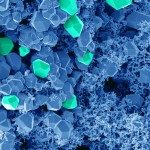Présentation
Séminaire du Département de Biologie Structurale & Chimie
VENDREDI 13 septembre 2019 à 14h00
Salle AUDITORIUM CENTRE F. JACOB – CFJ RdC 17c
Dr. David M. Perrin
Chem. Dept, U. British Columbia, UBC Vancouver, CANADA V6T-1Z1
Selection of RNaseA-mimicking DNAzymes with amines, imidazoles, and guanidines that cleave RNA: from unnatural aptamer selections unto to the origin of life
For ~40 years, the discovery of a Mg2+-independent catalyst capable of efficiently cleaving a specific mRNA target with multiple turnover has represented a formidable intellectual challenge with implications for unmet needs in anti-mRNA therapy.[1] While ribozymes and DNAzymes offered great conceptual promise towards this end, few therapeutic DNAzymes or ribozymes have emerged. Critical to this shortcoming has been the low intracellular Mg2+ concentration that is insufficient to support multiple turnover catalysis by unmodified nucleic acid catalysts in cells. As such, while the promise of catalytic nucleic acids endures (no one doubts the initial promise), its actualization remains unrealized, and thus presents a heightened impetus to develop chemically modified DNAzymes to overcome this incontrovertible limitation. Over the past two decades, we have worked to interface chemically modified deoxynucleoside triphosphates (dNTPs) with combinatorial selection to seek DNAzymes with protein-like functionalities for catalysis in in Mg2+-free regimes.
These exceptional catalysts display classic enzymatic properties of Michaelis-Menten kinetics in the absence of Mg2+ and exhibit rate constants that are 3-4 orders of magnitude greater than those observable with unmodified catalysts when evaluated in the low-to-no Mg2+ regime in cells. Applying Pauling’s “antibody-enzyme” analogy to the nucleic acid world, we note that DNAzymes are merely aptamers that bind one or more transition states. For RNA cleavage, the transition states are anionic and, thus, poorly recognized by unmodified nucleic acid catalysts. With a full electrostatic complement afforded by chemical modifications, this work beckons the use of modified dNTPs for the selection of modified aptamers that bind anionic ground states (instead of transition states). Operationally, we find that chemically modified nucleosides must either support faithful replication and readout, or be irretrievably lost in the course of a SELEX experiment – a powerful consequence of semi-conservative replication.[3] Our work highlights a chemist’s approach to testing hypotheses related to catalysis and molecular recognition along with the RNA-world where RNA must have co-opted amino-acid side chains in the presence of formaldehyde[4] that fed into an alleged formose reaction needed for anabolism.
References:
[1] a) R. Breslow, J. B. Doherty, G. Guillot, C. Lipsey, J. Am. Chem. Soc. 1978, 100, 3227-3229; b) H. Lonnberg, Org. Biomol. Chem. 2011, 9, 1687-1703.
[2] a) D. M. Perrin, T. Garestier, C. Hélène, Nucleosides Nucleotides 1999, 18, 377-391; b) L. Lermer, Y. Roupioz, R. Ting, D. M. Perrin, J. Am. Chem. Soc. 2002, 124, 9960-9961; c) R. Ting, J. M. Thomas, L. Lermer, D. M. Perrin, Nucleic Acids Res. 2004, 32, 6660-6672; d) M. Hollenstein, C. J. Hipolito, C. H. Lam, D. M. Perrin, ChemBioChem 2009, 10, 1988-1992; e) J. M. Thomas, J. K. Yoon, D. M. Perrin, J. Am. Chem. Soc. 2009, 131, 5648-5658; f) M. Hollenstein, C. J. Hipolito, C. H. Lam, D. M. Perrin, Acs Combinatorial Science 2013, 15, 174-182; g) Y. J. Wang, E. K. Liu, C. H. Lam, D. M. Perrin, Chem. Sci. 2018, 9, 1813-1821.
[3] Y. J. Wang, N. Ng, E. K. Liu, C. H. Lam, D. M. Perrin, Org. Biomol. Chem. 2017, 15, 610-618.
[4] M. P. Robertson, S. L. Miller, Science 1995, 268, 702-705.
Contact : Marcel Hollenstein
Unité Chimie bioorganique des acides nucléiques
Marcel.hollenstein@pasteur.fr


